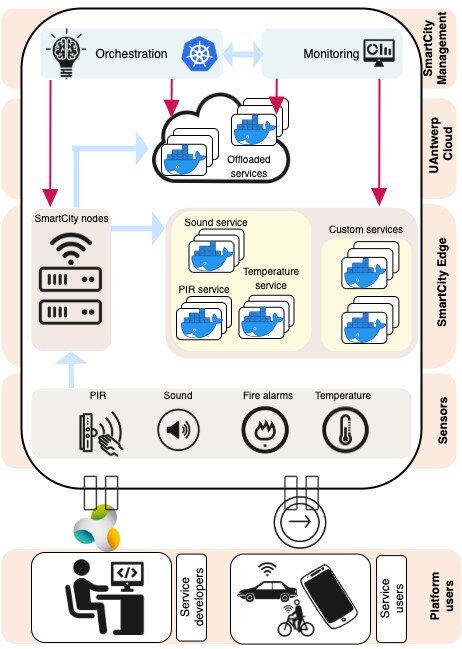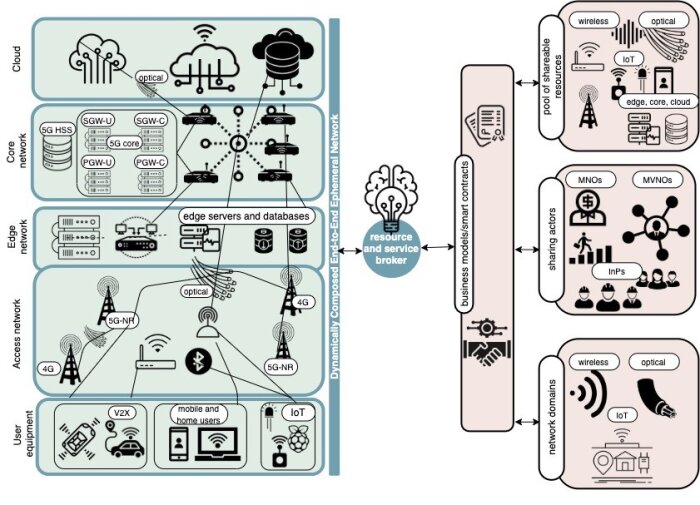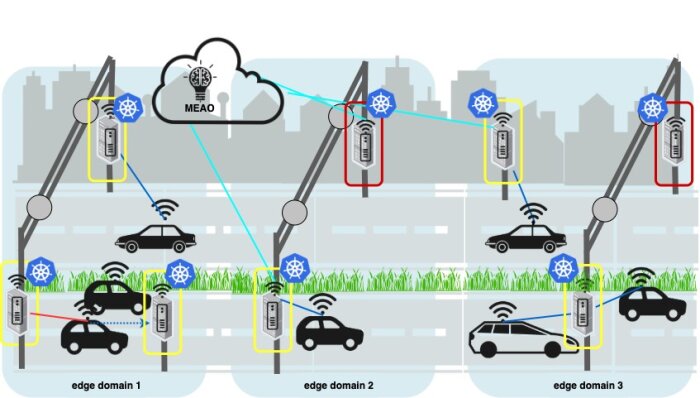In order to deliver current 5G demanding requirements, network management has the task to decide, given a limited amount of network and computing resources and data sources, where and when to execute each algorithm to offer the best possible performance. While cloud infrastructures have a huge amount of computing power available, they usually have higher delays. On the other hand, edge infrastructures have a very low delay, but computing power is normally much more limited.
The research community is still investigating the best solutions to this problem, especially in complex use cases that involve a large amount of sourced data or mobile clients that require fast response times and multiple active connections in the access network. Moreover, in order to provide flexibility to the network and to be able to place such algorithms and functions at any given location at the network, this research track explores different function placement techniques varying from PHY to APP layer diverse functionality.
Research examples
- Edge/Cloud Task allocation: In this research track we aim at enabling and providing insights on the trade-off and inter-play of edge and cloud computing, and at demonstrating how to intelligently decide when to move computation from the node to the edge and to the cloud. Many Smart City applications and services require a considerable amount of computing resources, which are not always fully available on the local nodes or at the edge (e.g., gateway nodes). This is the case of data-driven applications that require to process large amounts of data or third-party services running in the edge to reduce the end-to-end latency. Additionally, we focus on a close-loop life cycle that performs monitoring, control and orchestration to manage network services keeping the previously agreed QoS.
- MEC orchestration: There is an urgent need to leverage emerging technologies such as 5G and Multi-Access Edge Computing (MEC) to facilitate the performance of a myriad of applications. Therefore, this research track maps the architecture of MANO (management and orchestration) solutions to the closed-loop life cycle, i.e., monitoring, control and orchestration, to improve existing management of MEC applications. For instance, we require MEC orchestration solutions to support vehicular networking when dealing with a variety of safety, non-safety and infotainment vehicular applications. Since the expectations towards vehicular communications are increasing and as ultra-low latency is a primary and critical concern for autonomous driving, helping to achieve them is an ultimate goal for MEC orchestration.
- Programming the network flow: Due to the heterogeneity of nodes in vehicular networks, from cars, RSUs, cyclists and pedestrian, wireless mediums become volatile. One of the solutions to overcome the uncertainty is using Software Defined Network (SDN). SDN separates the data plane (in charge of switching/ routing the packets) from the control plane (in charge of defining how the traffic is handled) in order to facilitate network management. It, therefore, improves resource utilization in the networks thanks to the SDN controller. Routing of messages can be automatically performed by the SDN controller in a vehicular environment that has highly mobile nodes. This in turn having the controlled network traffic flow in a highly dynamic environment.
-
 Example of how the orchestration of tasks can be done in a Smart City use case. Depending on the specific task requirements (latency, CPU resources, etc.) tasks can be offloaded to the cloud or executed locally in the edge.
Example of how the orchestration of tasks can be done in a Smart City use case. Depending on the specific task requirements (latency, CPU resources, etc.) tasks can be offloaded to the cloud or executed locally in the edge. -
 Example of how a multi-domain end-to-end network can be dynamically instantiated. IDLab can enable the virtualisation of a common infrastructure through ETSI MANO/SDN/Network slicing technologies to dynamically offer isolated end-to-end network services to vertical applications.
Example of how a multi-domain end-to-end network can be dynamically instantiated. IDLab can enable the virtualisation of a common infrastructure through ETSI MANO/SDN/Network slicing technologies to dynamically offer isolated end-to-end network services to vertical applications.
-
 Orchestrating timely V2X applications on MECs deployed in roadside infrastructure using IDLab’s MEC Application Orchestrator (MEAO)
Orchestrating timely V2X applications on MECs deployed in roadside infrastructure using IDLab’s MEC Application Orchestrator (MEAO)
Involved faculty
Johann Marquez-Barja
